 |
 #INTHEAIREVERYWHERE
#INTHEAIREVERYWHERE |
|
| Vol.
17 No. 45 |
Friday
July 27, 2018 |
 |
| 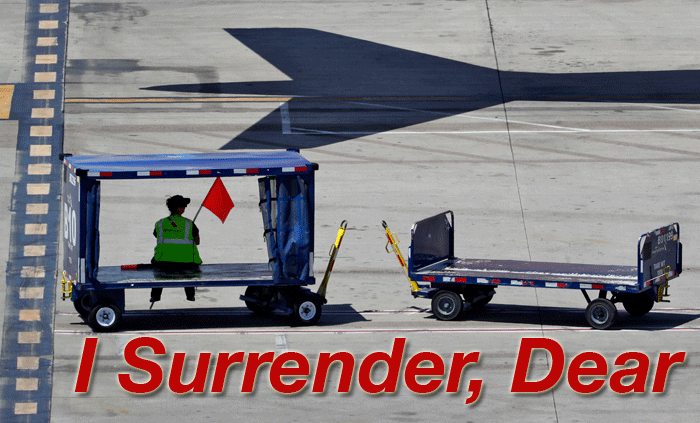
I Surrender . . . A member
of the American Airlines ground crew seeks shelter on an empty luggage
cart Wednesday, July 25, 2018 at Sky Harbor International Airport in Phoenix.
For the third straight day, Phoenix has
hit a record high temperature as Sky Harbor reached 115 degrees Monday
and Wednesday afternoon, according to the U.S. National Weather Service.
The July 25 record was set back in 1943.
Phoenix reached 116 degrees Tuesday, making it the hottest day of the
year so far.
Forecast is for continued heat topping 110
degrees this weekend.
|
|
One of the most important
pioneering journalists in air cargo history, Richard Malkin is
the only air cargo reporter who covered the Berlin Airlift; with that
one act, he practically invented air cargo journalism.
Richard died in July 2017 at the age of 104.
Richard Malkin was part of our print publication from 1990
until 1994. He returned to FlyingTypers at age 100 and wrote
continuously until mid-2016, supplying a flurry of final of interviews,
comments, and feature stories.
It is worth mentioning that Richard left us with a living
legacy of yet-to-be-published stories created in his final years. They
cover his exploits during an amazing 65+ years covering the air cargo
business.
This is a first in the series on air cargo from the beginnings
to the Jet Age.

Richard Malkin at The Reichstag Berlin, 1948.
 ir
cargo journalism was a career that I neither
planned nor anticipated. In fact, it did not
exist as a specific profession before I gave
up my job as a reporter for a daily newspaper
to assume the editorship of what billed itself
as the world’s first dedicated air cargo
periodical. This occurred a couple of years
before the dawn of the so-called Air Cargo
Age in domestic and international commerce
at the end of World War II. ir
cargo journalism was a career that I neither
planned nor anticipated. In fact, it did not
exist as a specific profession before I gave
up my job as a reporter for a daily newspaper
to assume the editorship of what billed itself
as the world’s first dedicated air cargo
periodical. This occurred a couple of years
before the dawn of the so-called Air Cargo
Age in domestic and international commerce
at the end of World War II.
The plain truth
is that my passage from newspaper to magazine
activity was purely an economic decision:
I harbored no interest in aviation or transportation.
Privately, I intended to hold on to the job
for several years, get onto firmer economic
ground, then shift to a more desirable editorial
environment.
As it turned
out, I lasted 66 years writing about all manner
of property moved by air.
Without realizing
it, I had been seized and held captive in
the powerful grip of diverse dynamic forces
in motion, not least the spectacle of the
horde of Air Transport Command and Naval Air
Transport service veterans, many of them with
overblown visions of their roles in this new
business called air cargo—a reminder,
as a wise man once pointed out, an exaggeration
is a truth that has lost its way. But more
about the Air Force hopefuls later in this
article.
At the time
of the new industry’s beginning—and
even before then—the absolute definition
of air cargo embraced all forms of property.
Not only did it cover express and freight,
but mail and baggage as well.
Dealing with
the monthly traffic statistics received from
the airlines, savvy editors soon learned to
verify the actual tonnage of shipments carried.
Adding to the statistical confusion, foreign
operators tended to report the results in
kilos in contrast to pounds or tons reported
by the U.S. airlines. A Civil Aeronautics
Board held tight rein on a new industry it
was learning to understand.
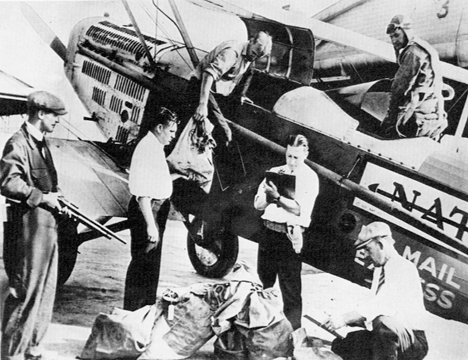 Despite, as previously indicated, the birth
of the Air Cargo Age at the end of hostilities
in 1945, scheduled air shipping in the U.S.
had been in existence since 1927 when a single-engine
aircraft of National Air Transport flew a
load of small packages and boxes from New
Brunswick, New Jersey to Chicago. This was
the origin of REA Air Express. A creature
of Railway Express Agency (owned by 80 railroads
which enjoyed a lucrative contract with the
nation’s scheduled airlines until international
competitive reverses decades later spelled
the agency’s end. An ambitious newcomer
with a service strategy all its own, popped
into existence.
Despite, as previously indicated, the birth
of the Air Cargo Age at the end of hostilities
in 1945, scheduled air shipping in the U.S.
had been in existence since 1927 when a single-engine
aircraft of National Air Transport flew a
load of small packages and boxes from New
Brunswick, New Jersey to Chicago. This was
the origin of REA Air Express. A creature
of Railway Express Agency (owned by 80 railroads
which enjoyed a lucrative contract with the
nation’s scheduled airlines until international
competitive reverses decades later spelled
the agency’s end. An ambitious newcomer
with a service strategy all its own, popped
into existence.
Nor was air
freight—bulk consignments—totally
absent in the pre-Air Cargo Age years. Pan
Am flew occasional planeloads of 24-hour baby
chicks to Latin American destinations, and
there were notable freight movements by TACA
and Avianca, and, yes, the Canadian bush 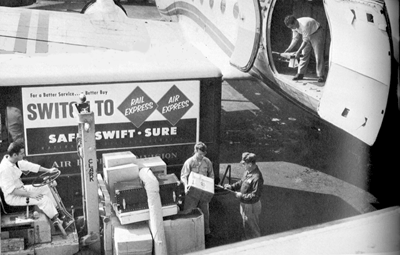 flyers,
but these were too few to signal an explosion
of freight revenue for the airlines. flyers,
but these were too few to signal an explosion
of freight revenue for the airlines.
From a running
start in the second half of the 1940s, significant
examples registered what the new industry
would look like in the future. Hauled in aircraft
that were pale shadows of today’s giant
jets, the world’s important airlines
gave evidence of starting hard- freight operations.
Consider, for example, a zoo-bound planeload
of assorted animals, including a baby elephant.
Or an entire household flown thousands of
miles to an overseas inland location. Or the
substitution of the speed of air cargo for
refrigerated ground or sea transport of perishable
commodities. To borrow a biblical expression,
the fledgling industry went annually from
strength to strength.
Like the history
of the surface transportation companies, the
appearance of the middleman inspired little
affection in airline ranks. The IATA-approved
commission-earning cargo agent preceded by
years the cargo-consolidating air freight
forwarder.
The rise of
the cargo agents was swift and dramatic. They
descended in large numbers on export communities
on both coasts and the Midwest. Typical of
the swarm of newly IATA-authorized cargo agents
was the avid chap armed with a desk, a phone
and a stack of air waybills. Facing traditional
shippers asked to pay rates sharply higher
than they were accustomed to pay, the cargo
agents turned patient and persistent educators,
setting forth the inherent economic advantages
produced by the speed of air transport. It
was no easy sell, and often—too often—price
was king, even under demonstrated proof that
air freight’s bottom line should be
preferable. Those were the days when physical
distribution executives were as rare as kiwis
in Yellowstone Park.
As the volume
of agent-derived traffic increased at a steady
pace, a few international air carriers questioned
internally whether it was smart to become
dependent on the agent for what may turn out
to be an interesting potential.
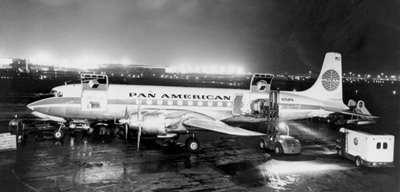 A leak at Pan Am disclosed that a key executive,
concerned that the cargo agents might achieve
control of the airline’s growing freight
business had proposed to open direct competition
against them if their input reached a threshold
of 20% of Pan Am freight revenue. The leaked
news produced an instant emergency meeting
of agents in a Manhattan restaurant, and after
emotional debate voted to make Pan Am the
carrier of last resort. Pan Am reacted quickly.
At a hastily arranged meeting with an agents
committee, it pooh-poohed the veracity of
the leak and offered calming words of support.
Out of that session came a period of mutually
guarded accord.
A leak at Pan Am disclosed that a key executive,
concerned that the cargo agents might achieve
control of the airline’s growing freight
business had proposed to open direct competition
against them if their input reached a threshold
of 20% of Pan Am freight revenue. The leaked
news produced an instant emergency meeting
of agents in a Manhattan restaurant, and after
emotional debate voted to make Pan Am the
carrier of last resort. Pan Am reacted quickly.
At a hastily arranged meeting with an agents
committee, it pooh-poohed the veracity of
the leak and offered calming words of support.
Out of that session came a period of mutually
guarded accord.
 Forwarder consolidations of high-rated small
shipments incited no yelps of glee from the
airlines. They were largely regarded by the
carriers as competitors. The airlines’
darling of the latter Forties was Emery Air
Freight whose pricing in its startup year—it
refrained from competing with domestic airline
rates unlike the other intermediaries—it
sold and delivered top-quality service before
the iron realities of the marketplace compelled
it to offer competitive rates.
Forwarder consolidations of high-rated small
shipments incited no yelps of glee from the
airlines. They were largely regarded by the
carriers as competitors. The airlines’
darling of the latter Forties was Emery Air
Freight whose pricing in its startup year—it
refrained from competing with domestic airline
rates unlike the other intermediaries—it
sold and delivered top-quality service before
the iron realities of the marketplace compelled
it to offer competitive rates.
As an air cargo
innocent, virgin territory each workday was
an experience in discovery, often familiar
but in a totally different context. It was
both fascinating and challenging. The determined
forces of a pulsing creative bent, of steady
focus of expectation in a still blurry tomorrow.
Not very long
after the return of peace, I found myself
tramping California’s strawberry and
lettuce fields, and covering stretches of
Florida and Texas flower growers. I watched
the careful offloading of Jamaica lilies for
the Easter market. A bit later I flew to the
Netherlands for an eye-opening visit at the
fabulous flower auction in Aalsmeer. It did
not take genius thinking to understand why
these perishable products were among the first
natural candidates to take to the air. This
led to my discovery that varieties of fish
had donned wings. Interesting to note is that
the Air Cargo Age was only three years old
when Lockheed engineers participated in tests
of the effects of altitude and changes of
pressures on 34 different types of fruits
and vegetables.
I can conceive
of no better descriptive word than “wonderland”
for those pristine years. Close witness to
extraordinary feats of freight flying, I was
reminded that all fine things descend from
originality; for the first time restaurants
in interior cities received fresh fish from
Eastern waters . . . A ship’s propeller
weighing 6 1/2 tons, too long for normal loading,
slung on specially constructed beams beneath
the fuselage; an overseas tramp operator picks
up and delivers random shipments to a series
of airports on a circuitous route.
Yes, all the
above—and more!—when commercial
air cargo was still in diapers.
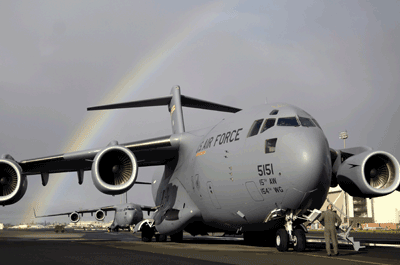 In a published work some years ago I noted
an incident involving an ATC veteran who paid
a visit to my office about a year after the
war. In a broad display of unsophisticated
candor he charmingly informed me that he had
acquired a war-surplus C-47 cargoplane, and
could I tell him how to go about getting into
the airline business.
In a published work some years ago I noted
an incident involving an ATC veteran who paid
a visit to my office about a year after the
war. In a broad display of unsophisticated
candor he charmingly informed me that he had
acquired a war-surplus C-47 cargoplane, and
could I tell him how to go about getting into
the airline business.
I mention this
because he was typical of scores of ex-service
flyers and handlers whose postwar ambitions
pointed in the same direction. The immediate
postwar era showed explosive growth of what
now were often called “GI airlines”—all
nonscheduled airlines, many of these new air
carrier companies built on the strength of
a single war-surplus transport. Rise and fall—it
took a few short years, victims of the tough
realities in marketing, pricing and, of course,
competition.
But a few hardier
ones survived, a small number longer than
the rest. Among these escapees from nonscheduled
to become scheduled carriers. This small group
included such familiar brands as Flying Tiger,
Slick, Seaboard, etc, now fading memories.
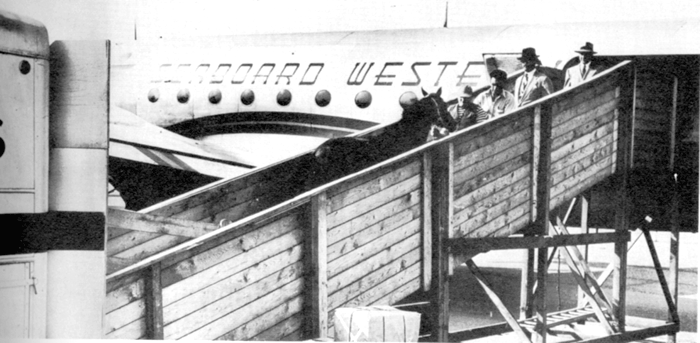
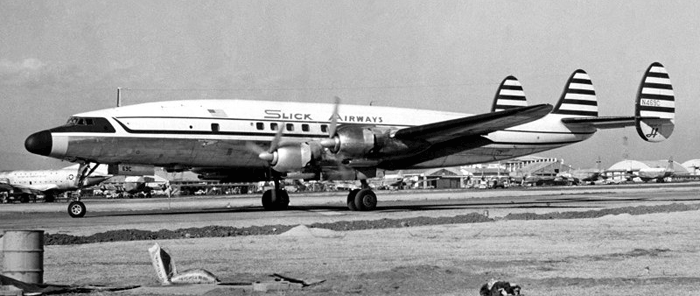
|
In spite of their record during the first few years,
they are generally credited for a significant contribution to awareness
of the plane as a true component of modern distribution.
Having passed through the entire life of
the air cargo industry to date, I found myself effortlessly settling on
the earliest years—the years when imaginations and hopes ran riot—as,
for me, a spell of utter romance. (What was inevitably to follow was a
parabola of mammoth jetfreighters, automated cargo handling, containerization,
brilliant applications of modern technology, fierce competition on a global
scale.)
Passenger-oriented from the very start,
the scheduled airlines’ development of revenue from the carriage
of cargo above REA’s contributions was at low ebb. There was a certain
charismatic glow bathing sales people who often rubbed elbows with celebrity
passengers. A man assigned to cargo was likely said to have been exiled
to Siberia. (A former top executive at Lufthansa admitted to me that in
his youth at the German airline, cargo was referred to as a fifth wheel.)
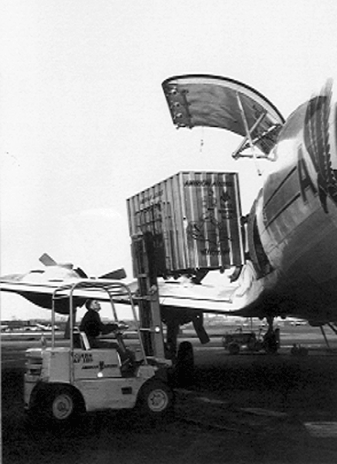 Gradually, but with increasing frequency, bulk shipments moved into the
air. American Airlines anticipated what lay ahead and was the first to
offer scheduled all-cargo service. Its inaugural freighter flight flew
from New York to Burbank, including several intermediate stops.
Gradually, but with increasing frequency, bulk shipments moved into the
air. American Airlines anticipated what lay ahead and was the first to
offer scheduled all-cargo service. Its inaugural freighter flight flew
from New York to Burbank, including several intermediate stops.
As sure as the daily rise of the sun, there
came the crop of unabashed prognosticators to spread the good word. There
was a happy aura of certainty that surrounded their expressions. One by
one, airline and forwarder executives donned the seer’s mantle and
seriously issued predictions that airline cargo revenue would pull abreast
passenger revenue in—depending on the predictor’s gift of
prophecy—10 to 15 years. Ralph S. Damon, then president of TWA,
proved to be more conservative! He maintained that it would take about
25 years. The ensuing decades proved that Pliny the Elder had it right:
the only certainty is that nothing is certain.
This article of memory-wresting details
is essentially devoted to the postwar Forties with one or two brief forays
beyond. It is meant to focus on elements—at least some basic ones—that
formed the arc that was dubbed the Air Cargo Age.
On a path that was to lead to an ultimate
global aerial network fat with the goods of man, there were trial and
error, success and disappointments, visionaries and naysayers. All things
considered, I am inclined to say that the first few years of my six-and-a-half
decade career in air cargo were crammed with the stuff of pure romance.
The industry’s green years had, as
shown, its crop of dreamers and those comfortably wrapped in tradition.
The dreamers stretched the bounds of possibility. Along with their dreams
of global airfreighter fleets were predictions of complementary services
by airships, helifreighters, and parachuted deliveries. Is dreaming an
exercise in futility? There is an old French suggestion—Tous
songes sont mensonges (all dreams are lies).
Don’t you believe it.
Richard Malkin
|
 |
While out walking the dog recently, I looked
up and noted white smoke lettering scrawled across the sky, spelling out
the word Geico.
I knew right away that Skytypers were hard
at work, as they have been for years during summer.
Skytypers owner Morty Arkin was based in the
Marine Air Terminal, where Air Cargo News held offices for nearly a quarter
of the 20th century.
We were good friends along with Tim Peirce,
the LaGuardia Airport manager who found a place at the field for people
like us and Doc Herrlin, the neighborhood kid who grew up and went into
the medical arts, practicing at the airport because, like all of us, he
loved the place.
Now Tim and Morty and John Herrlin are gone.
Last week we learned the First Lady of LaGuardia
Airport for more than 20 years, Cary Peirce, unexpectedly died on June 26,
2018.
Cary was great. Her contagious sense of humor
and quick wit was always like a breath of fresh air in an era of smoked-filled
rooms.
I first met Cary up in Fairfield, where Tim
and Cary lived with their two daughters, Amanda and Jennifer.
The home was warm and all country, with a
barn where the Peirce’s kept their Model A Ford pickup truck, and
a pasture out back big enough to land a private airplane.
We had all trudged to Fairfield to celebrate
one thing or another going on at LaGuardia Airport, and I recall Cary that
day was having none of it.
None of it with the boys, that is.
Cary obviously had worked hard setting up
the food and drinks and had opened up the house, surrendering the place
to us.
I always loved that home in Fairfield because,
among other things, it was the living proof of a cartoon by James Thurber
called “House & Woman.”
The moment you entered the front door, the
place just simply wrapped itself around you with the spirit of Cary.
For that LaGuardia Airport manager’s
day in Fairfield, she spent the entire day with the wives and girlfriends,
making it clear that her agenda was advancing the conversation about women,
but we all felt that she was with us right in the middle of things.
At the end of the party, Cary gave Sabiha
three different kinds of mint from the Peirce garden, explaining their best
usage.
Today, nearly 40 years later, that mint still
appears yearly in our garden here at home.
Every time the strains of “My Old Kentucky
Home” play, marking the start of the Derby, I run outside and pick
some of that mint for the juleps, just as Cary instructed, and think of
her.
She was gentle and sweet with all of us. But
she did not suffer fools and was very firm and dedicated to her agenda,
which included the betterment and enrichment of the airport experience and
beyond that, the community where she lived, Fairfield, Connecticut.
When Tim died in 2000, they held a memorial
service for him at the Marine Air Terminal.
The memorial took on the trappings of an official
Port Authority event, so I quietly asked Cary if I could read the notes
I had written for Tim to her personally and she said yes.
I recall quoting the John Donne poem that
was also the title of the Hemingway book, For Whom The Bell Tolls:
“If a clod be washed away by the
sea, Europe is the less, as well as if a promontory were, as well as if
a manor of thy friend’s or of thine own were: any man’s death
diminishes me, because I am involved in mankind, and therefore never send
to know for whom the bells tolls; it tolls for thee.”
I handed her the slip of paper with those
words and a kiss. She said thanks, gave me a second hug, and walked away.
Now, for nearly 18 years since Tim passed,
every January our publication recalls something about those golden years
at LaGuardia.
During that time we have stayed in touch with
Cary as we both shared some moments that continue to shine brightly in the
rearview mirror.
Somebody wrote that Cary has joined her husband,
Tim, in heaven, and that without a doubt is true.
But we liked it better with Cary down here.
I think I’ll go outside and pick some
mint.
Geoffrey Arend |
 |
Publisher-Geoffrey
Arend • Managing Editor-Flossie Arend • Editor Emeritus-Richard
Malkin
Film Editor-Ralph Arend • Special Assignments-Sabiha Arend, Emily
Arend • Advertising Sales-Judy Miller |
 Send
comments and news to geoffrey@aircargonews.com Send
comments and news to geoffrey@aircargonews.com
Opinions and comments expressed herein do not necessarily reflect the
views of the publisher but remain solely those of the author(s).
 Air
Cargo News FlyingTypers reserves the right to edit all submissions
for length and content. All photos and written material submitted to
this publication become the property of All Cargo Media. Air
Cargo News FlyingTypers reserves the right to edit all submissions
for length and content. All photos and written material submitted to
this publication become the property of All Cargo Media.
All Cargo Media, Publishers of Air Cargo News Digital and FlyingTypers.
Copyright ©2018 ACM, Inc. All Rights Reserved.
More@ www.aircargonews.com
 100%
Green 100%
Green
|
|
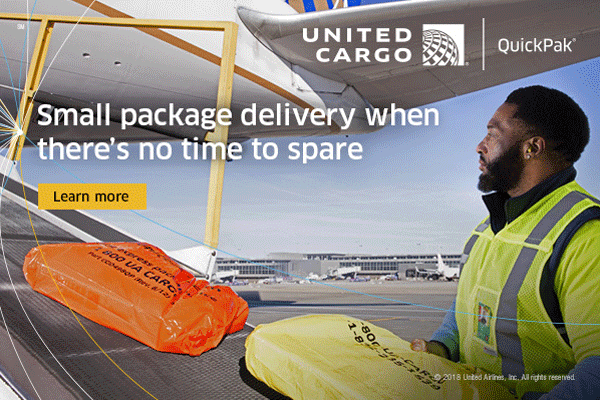




 Vol.
17 No. 42
Vol.
17 No. 42 Vol.
17 No. 43
Vol.
17 No. 43





 Despite, as previously indicated, the birth
of the Air Cargo Age at the end of hostilities
in 1945, scheduled air shipping in the U.S.
had been in existence since 1927 when a single-engine
aircraft of National Air Transport flew a
load of small packages and boxes from New
Brunswick, New Jersey to Chicago. This was
the origin of REA Air Express. A creature
of Railway Express Agency (owned by 80 railroads
which enjoyed a lucrative contract with the
nation’s scheduled airlines until international
competitive reverses decades later spelled
the agency’s end. An ambitious newcomer
with a service strategy all its own, popped
into existence.
Despite, as previously indicated, the birth
of the Air Cargo Age at the end of hostilities
in 1945, scheduled air shipping in the U.S.
had been in existence since 1927 when a single-engine
aircraft of National Air Transport flew a
load of small packages and boxes from New
Brunswick, New Jersey to Chicago. This was
the origin of REA Air Express. A creature
of Railway Express Agency (owned by 80 railroads
which enjoyed a lucrative contract with the
nation’s scheduled airlines until international
competitive reverses decades later spelled
the agency’s end. An ambitious newcomer
with a service strategy all its own, popped
into existence. flyers,
but these were too few to signal an explosion
of freight revenue for the airlines.
flyers,
but these were too few to signal an explosion
of freight revenue for the airlines. A leak at Pan Am disclosed that a key executive,
concerned that the cargo agents might achieve
control of the airline’s growing freight
business had proposed to open direct competition
against them if their input reached a threshold
of 20% of Pan Am freight revenue. The leaked
news produced an instant emergency meeting
of agents in a Manhattan restaurant, and after
emotional debate voted to make Pan Am the
carrier of last resort. Pan Am reacted quickly.
At a hastily arranged meeting with an agents
committee, it pooh-poohed the veracity of
the leak and offered calming words of support.
Out of that session came a period of mutually
guarded accord.
A leak at Pan Am disclosed that a key executive,
concerned that the cargo agents might achieve
control of the airline’s growing freight
business had proposed to open direct competition
against them if their input reached a threshold
of 20% of Pan Am freight revenue. The leaked
news produced an instant emergency meeting
of agents in a Manhattan restaurant, and after
emotional debate voted to make Pan Am the
carrier of last resort. Pan Am reacted quickly.
At a hastily arranged meeting with an agents
committee, it pooh-poohed the veracity of
the leak and offered calming words of support.
Out of that session came a period of mutually
guarded accord. Forwarder consolidations of high-rated small
shipments incited no yelps of glee from the
airlines. They were largely regarded by the
carriers as competitors. The airlines’
darling of the latter Forties was Emery Air
Freight whose pricing in its startup year—it
refrained from competing with domestic airline
rates unlike the other intermediaries—it
sold and delivered top-quality service before
the iron realities of the marketplace compelled
it to offer competitive rates.
Forwarder consolidations of high-rated small
shipments incited no yelps of glee from the
airlines. They were largely regarded by the
carriers as competitors. The airlines’
darling of the latter Forties was Emery Air
Freight whose pricing in its startup year—it
refrained from competing with domestic airline
rates unlike the other intermediaries—it
sold and delivered top-quality service before
the iron realities of the marketplace compelled
it to offer competitive rates. In a published work some years ago I noted
an incident involving an ATC veteran who paid
a visit to my office about a year after the
war. In a broad display of unsophisticated
candor he charmingly informed me that he had
acquired a war-surplus C-47 cargoplane, and
could I tell him how to go about getting into
the airline business.
In a published work some years ago I noted
an incident involving an ATC veteran who paid
a visit to my office about a year after the
war. In a broad display of unsophisticated
candor he charmingly informed me that he had
acquired a war-surplus C-47 cargoplane, and
could I tell him how to go about getting into
the airline business.

 Gradually, but with increasing frequency, bulk shipments moved into the
air. American Airlines anticipated what lay ahead and was the first to
offer scheduled all-cargo service. Its inaugural freighter flight flew
from New York to Burbank, including several intermediate stops.
Gradually, but with increasing frequency, bulk shipments moved into the
air. American Airlines anticipated what lay ahead and was the first to
offer scheduled all-cargo service. Its inaugural freighter flight flew
from New York to Burbank, including several intermediate stops.
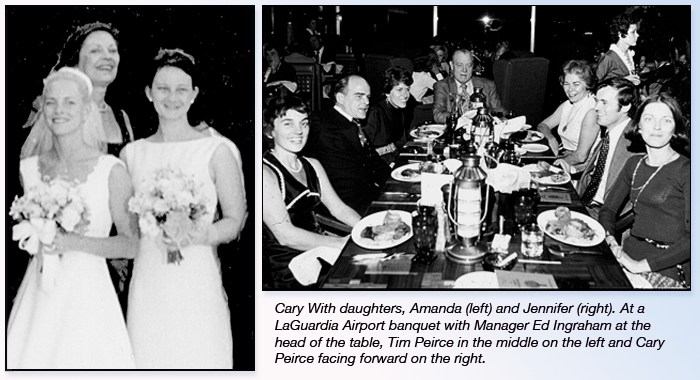

 Air
Cargo News FlyingTypers reserves the right to edit all submissions
for length and content. All photos and written material submitted to
this publication become the property of All Cargo Media.
Air
Cargo News FlyingTypers reserves the right to edit all submissions
for length and content. All photos and written material submitted to
this publication become the property of All Cargo Media.